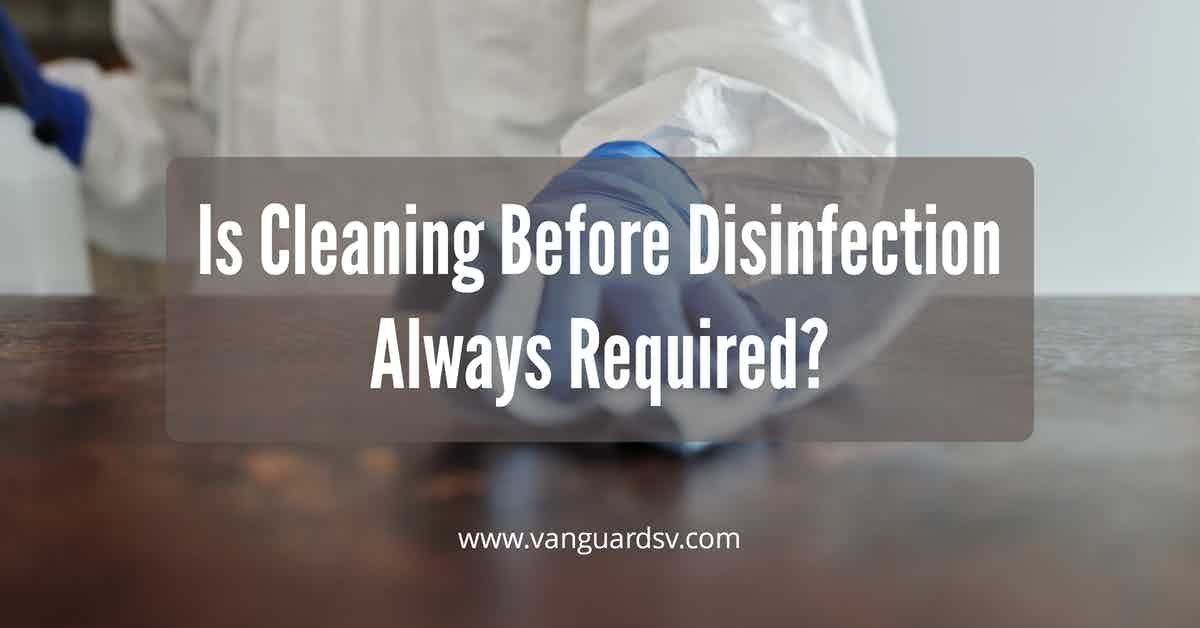The general rule of thumb for sanitizing a surface is to first clean to remove visible soil, then disinfect to kill unseen germs, mold, mildew, fungus, and bacteria, but that may not always be necessary.

Why We Clean Before Disinfecting
Soap-based detergents are used to clean and remove visible soil, bacteria, pathogens, and other microbes from surfaces, but typically do not kill anything.
The exception to the rule regarding soap's ability to kill pathogens is enveloped viruses, such as coronaviruses, surrounded by a layer of fat that the soap destroys, resulting in pathogen inactivation.
Additionally;
- Sanitizers reduce the number of bacteria on surfaces.
- Disinfectants kill infectious fungi, bacteria, and viruses.
- Virucides kill or irreversibly inactivate pathogens, and;
- Sterilants kill all forms of microbial life, including fungi, spores, bacteria, and viruses.
We clean with soap and water first because sanitizers, disinfectants, and similar products are inefficient at penetrating dirt, soil, oils, and other microbial matter, which soap is extremely proficient at removing.
Failing to clean visibly soiled surfaces before applying a disinfectant or virucide will likely result in undesirable outcomes--a surface that is still contaminated or soil that promotes the growth of harmful microbes.
Is Cleaning First Always Necessary?
The COVID-19 pandemic shed light on low-quality facility sanitation practices and the challenges surrounding cleaning large, heavily trafficked areas of a building.
A critical lesson that was learned early on was when it is appropriate to disinfect without cleaning, or where cleaning with soap and water may be a superior option.
For example, in an attempt to make facilities safe for human occupation as quickly and efficiently as possible, many facility managers and business owners opted to essentially douse their buildings and furniture in bleach or similar disinfectant products and hope for the best.
This approach proved to be heavily flawed.
Repeated high doses of concentrated disinfectant are entirely unnecessary--as previously mentioned, the fatty layer surrounding coronaviruses (lipid) is vulnerable to regular soap and water.
Blasting every surface with toxic chemicals was unnecessary, inefficient, ignored the principles of targeted cleaning based on need, and completely disregarded occupant health and potential environmental challenges.
However, applying soap-based detergents to every surface in an occupied building multiple times per day is, essentially, impossible.
These challenges led to a rapid reassessment of long-accepted cleaning and disinfection commandments and the adoption of newer, more effective technologies.
The first thing to go was the adage of always clean before disinfecting.
According to the U.S. Centers for Disease Control and Prevention (CDC), daily cleaning is only required for visibly soiled surfaces in areas of a building that have been occupied in the last seven days.
The second myth to go was that every conceivable surface in an occupied facility must be disinfected every day.
According to the CDC, heavily touched surfaces, commonly referred to as germ hotspots, should be prioritized for disinfection.
Further, the CDC has emphasized the importance of considering the type of surface you are sanitizing when determining how it should be cleaned or disinfected.
For example, it is extremely impractical and potentially dangerous to clean electronic devices with soap and water, so a safe delivery method of an EPA-registered disinfectant will almost always be called for.
Conversely, soft, porous surfaces, such as curtains, carpet, and rugs can be cleaned with a detergent, and disinfected or laundered safely, depending on manufacturer recommendations.
Cleaning and Disinfection Best Practices
Cleaning should be performed regularly in occupied areas of a building, especially dining areas, break rooms, and restrooms.
In general, cleaning products can be applied liberally with little danger to occupant health or the environment.
Disinfection should, for the most part, be targeted for occupied areas of a building and can be performed without cleaning first if there is no visible soil or if regular cleaning occurs throughout the week.
Cleaning should be performed with an EPA-registered commercial-grade soap-based detergent and a clean microfiber towel or mophead.
Disinfecting should be performed with an EPA-registered disinfectant product that makes the recognized claim against the microbe you are trying to kill with an application method appropriate for your facility and the surface being cleaned.
Advanced cleaning technologies, such as no-touch scrubber vacuums, are extremely efficient at sanitizing restrooms, kitchens, and other areas generally covered in hard surfaces.
Electrostatic disinfection appliances are ideal for disinfecting large areas quickly and efficiently and can be used on commercial electronics.
References & Resources
- Sanitizers vs. Disinfectants: What's the Difference?
- Cleaning and Disinfecting…Why You Need To Do Both
- Cleaning and Disinfecting Your Facility
Takeaway
Cleaning efficiently and effectively with a focus on occupant and environmental health is paramount for long-term sustainability, even in the face of a global pandemic.
Shotgun disinfection applications are dangerous, ineffective, and wasteful.
A highly trained janitorial service provider will competently establish a cleaning and disinfection plan that considers all factors, including surface type, occupant vulnerability, EPA guidelines, and facility occupancy and use requirements.
Outsourcing is a proven method for ensuring the highest standards of cleanliness, safety, and training while controlling costs and eliminating management overhead.
If you would like more information regarding the effectiveness of high-performance infection prevention and control measures, or if you would like to schedule a free, no-obligation onsite assessment of your facility's custodial needs, contact us today for a free quote!
In Bakersfield, CA, call (661) 437-3253
In Fresno, CA, call (559) 206-1059
In Valencia CA, or Santa Clarita CA, call (661) 437-3253
In Palmdale, CA or Lancaster, CA, call (661) 371-4756

